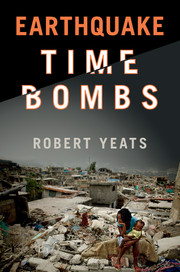Book contents
- Frontmatter
- Contents
- Acknowledgments
- Why this book?
- PART I EARTHQUAKES, DEEP TIME, AND THE POPULATION EXPLOSION
- PART II EARTHQUAKE TIME BOMBS
- TIME BOMBS WHERE THE PROBLEM IS UNDERSTOOD, BUT THE RESPONSE IS STILL INADEQUATE
- OTHER TIME BOMBS, INCLUDING CITIES THAT ARE NOT WELL PREPARED
- 13 Age of Enlightenment and the 1755 Lisbon earthquake
- 14 Jerusalem: earthquakes in the Holy Land
- 15 Istanbul: responding to an official earthquake warning
- 16 Tehran: the next earthquake in the Islamic Republic of Iran?
- 17 Kabul: decades of war and Babur's warning
- 18 Earthquakes in the Himalaya
- 19 Myanmar and the Sagaing fault
- 20 Metro Manila, the Philippines
- 21 Lima, Peru: Inca earthquake-resistant construction and a bogus American earthquake prediction
- 22 Andean earthquakes in Quito and Guayaquil, Ecuador
- 23 Caracas: lots of oil, but little interest in earthquakes
- 24 Haiti, which lost its gamble, and Jamaica and Cuba (not yet)
- 25 Mexico City: bowl of jello inherited from the Aztecs
- 26 Central America and the earthquake that brought down a dictator
- 27 East African Rift Valley: a tale of two cities
- PART III SUMMARY AND RECOMMENDATIONS
- References
- Index
22 - Andean earthquakes in Quito and Guayaquil, Ecuador
from OTHER TIME BOMBS, INCLUDING CITIES THAT ARE NOT WELL PREPARED
Published online by Cambridge University Press: 05 November 2015
- Frontmatter
- Contents
- Acknowledgments
- Why this book?
- PART I EARTHQUAKES, DEEP TIME, AND THE POPULATION EXPLOSION
- PART II EARTHQUAKE TIME BOMBS
- TIME BOMBS WHERE THE PROBLEM IS UNDERSTOOD, BUT THE RESPONSE IS STILL INADEQUATE
- OTHER TIME BOMBS, INCLUDING CITIES THAT ARE NOT WELL PREPARED
- 13 Age of Enlightenment and the 1755 Lisbon earthquake
- 14 Jerusalem: earthquakes in the Holy Land
- 15 Istanbul: responding to an official earthquake warning
- 16 Tehran: the next earthquake in the Islamic Republic of Iran?
- 17 Kabul: decades of war and Babur's warning
- 18 Earthquakes in the Himalaya
- 19 Myanmar and the Sagaing fault
- 20 Metro Manila, the Philippines
- 21 Lima, Peru: Inca earthquake-resistant construction and a bogus American earthquake prediction
- 22 Andean earthquakes in Quito and Guayaquil, Ecuador
- 23 Caracas: lots of oil, but little interest in earthquakes
- 24 Haiti, which lost its gamble, and Jamaica and Cuba (not yet)
- 25 Mexico City: bowl of jello inherited from the Aztecs
- 26 Central America and the earthquake that brought down a dictator
- 27 East African Rift Valley: a tale of two cities
- PART III SUMMARY AND RECOMMENDATIONS
- References
- Index
Summary
INTRODUCTION
Ecuador is the smallest Andean country in South America, bounded by Colombia on the north and Peru on the south. The country was founded as the Kingdom of Quito in AD 980, which was later conquered by an Inca army from Peru in 1462. The Inca occupation lasted until 1534, when the Inca empire was defeated by the Spanish. The Spanish occupation was similar to that in other parts of South America: brutal enslavement of Ecuador's inhabitants and forced conversion to Catholicism. Ecuador became part of the Viceroyalty of Peru in 1563. The country remained under the rule of Spain until it was liberated by Simón Bolívar in 1822.
The two largest cities, Quito and Guayaquil, were founded in the sixteenth century. The capital city of Quito is located in a high Andean valley (Depresión Interandina, or Inter-Andean Depression; Figure 22.1) at an elevation of 9350 feet (2800 m), whereas Guayaquil, the main port of Ecuador, is on the banks of the Guayas River near the shores of the Gulf of Guayaquil. Quito's population was 10,000 in the last days of Spanish rule, and it has grown to more than two million today. Guayaquil had 2000 inhabitants in AD 1600, but at the present time its population is more than 2.3 million, making it the largest city in Ecuador, larger than Quito, the national capital.
GUAYAQUIL AND COASTAL AND OFFSHORE ECUADOR
Both Guayaquil and Quito are subject to earthquakes, but the earthquakes endangering Guayaquil are far different from those affecting Quito. Guayaquil's hazard is from the subduction zone driving the oceanic Nazca Plate east-northeastward beneath the South American continent at a rate of nearly 3 inches (7 cm) per year. A complication is that the Nazca oceanic plate is not a smooth slab but contains a mountainous highland called the Carnegie Ridge that is colliding with the continent (Figure 22.1). The highest mountains on the Carnegie Ridge rise up from the ocean floor above sea level as the Galápagos Islands, themselves a dependency of Ecuador. The Carnegie Ridge intersects the South American continent west of low coastal hills northwest of Guayaquil. All of the large subduction-zone earthquakes have affected coastal Ecuador and Colombia north of the city and north of the Gulf of Guayaquil.
- Type
- Chapter
- Information
- Earthquake Time Bombs , pp. 262 - 269Publisher: Cambridge University PressPrint publication year: 2015



